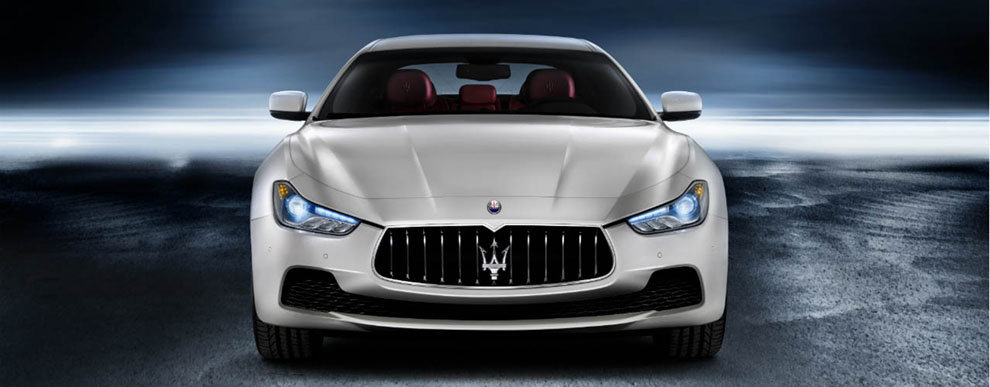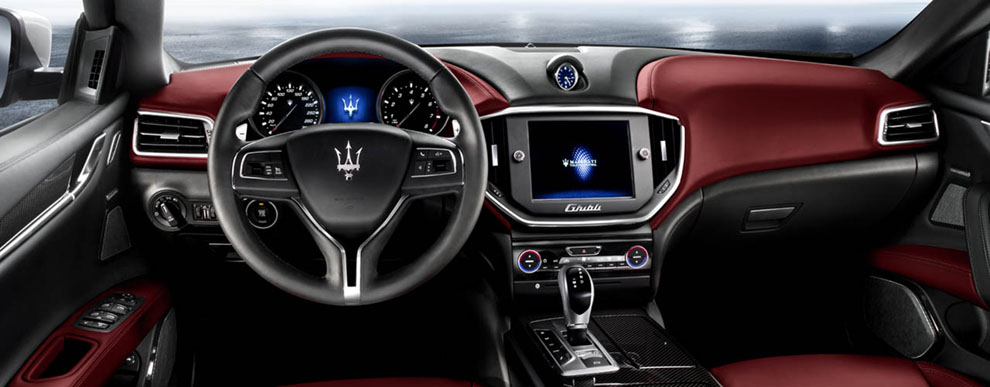The Maserati Ghibli is a midsize sports sedan with a Ferrari engine, a Chrysler infotainment system and Maserati trident badging everywhere.
The Ghibli (“gib-lee”) represents the growing pains of the 21st century global hodgepodge automaker.
Fiat Chrysler Automobiles, led by fellow Italian Sergio Marchionne, who deems giant automotive mergers as the only way forward, is the parent company of Alfa Romeo, which makes superfun toy cars for the weekend; Ferrari, which makes ridiculous supercars; Fiat, which makes more practical but still stylish compacts; and Maserati, which makes luxury sports sedans and coupes that can be driven every day.
All the Italian sub-brands are poised for growth under Marchionne, and Maserati might be the clearest indicator of how to take a niche brand and blow up its global presence.
Sales jumped 136 percent in 2014 on sales of 36,500 cars worldwide, with the GranTurismo and convertible GranCabrio accounting for less than 10 percent.
The least expensive of four models, the Ghibli has led the global charge, accounting for over 64 percent of sales in Maserati’s record 2014 year. It is the little brother to the full-size Quattroporte, which is nearly a foot longer, and will be the basis for the forthcoming key to Maserati’s growth strategy: the Levante crossover, of course, expected for model year 2017.
Both the Ghibli and Quattroporte were relaunched for 2014 to coincide with the centennial of the Italian brand, whose racing history is as legendary as its 20th century rivalry with Ferrari.
Fiat rescued Maserati in the early ’90s, which was the last time the Ghibli nameplate was used on a sports coupe. That was before Ferrari took ownership of Maserati and the cold hand of capitalism iced their feud.
Maserati benefits from increases in marketing and production under FCA, which then takes away from the very exclusivity that makes the prestige brand attractive.
Brands change like everything else, so if the new Maserati is slightly less prestigious and offers a crossover, roll with it. The disconnect comes when it still carries the old level of exclusivity in its price tag.
Our $95,000 test model (base of $78,000) raises the question of how much a brand is worth. The answer differs for each brand and each owner.
The Ghibli competes with the Audi S6, Lexus GS F, BMW M5. A similarly sized Cadillac ATS-V with much greater technological sophistication comes well equipped at just over $70,000. Is telling people you drive a Maserati – is flashing the trident – worth that much more?
The ATS-V has better performance chops than the Ghibli, but the Ghibli feels more distinguished on the inside.
On the outside, the sport-tuned all-wheel-drive Ghibli S Q4 wears its Italian heritage proudly, with sexy sculpted lines with an elongated dipped-down nose similar to the Jaguar F-Type and the rounded rear end favored by most luxury performance cars.
New for 2015 are standard 19-inch wheels. The nose seems a bit unnecessarily long, serving as a nest for fallen leaves in the 6-inch space between the decorative slats holding the trident and the actual grille.
Behind that grille is the S engine, a 3.0-liter twin-turbo V-6 that generates 404 horsepower and 406 pound-feet of torque in Sport mode. The twin-turbo enables max torque at just 1,750 rpm, so the driver is never wanting for more acceleration and never waiting for the turbo blast.
The engine dynamics, and the concert it creates out of those dual twin tailpipes, is a thing of beauty, perfectly matching the inputs and the moods of the driver. There’s a civilized hum with normal acceleration, an absence of sound at cruising speed, but if you want to bust out of work like a teenager from the minimum wage job that helped pay for your first car, you’re going to have a blast.
Press Sport mode and hear the valves burble and pop, let off the acceleration and the rev matching downshift growls.
At just under five seconds, it doesn’t have the fastest 0-60 mph, but this heavy car (4,124 pounds) is fleet-footed.
The heavy weight is spaced evenly, so you can dive into and jam out of corners without so much as a squeal from the wheels. It stays low to the ground and centered. A neat torque-distribution display in the instrument panel shows how torque is distributed to the front and rear wheels, which the system appropriately favors.
The meaty steering wheel feels good, despite the paddle shifters mounted on the steering column, and handling is firm enough. Despite the even weight distribution, the Ghibli will never be mistaken for a Porsche, and I’d have more confidence on the track in an ATS-V.
The main problem with the performance of the Ghibli is that the paddle shifters are mounted on the steering column. The paddles don’t turn with the wheel, making it difficult to shift while turning, which you wouldn’t do in most everyday driving situations anyway.
It’s a minor thing, and the 8-speed automatic transmission is quick enough to not use the paddle shifters at all, but then why include them? They also make it a reach to hit the left-hand turn stalk.
Mounting the shifters on the column instead of the wheel lets the engineers leave the volume and radio tuning buttons on the back of the steering wheel as part of the Chrysler infotainment system.
Those buttons are great on a Ram truck, not so much on a performance sedan. The infotainment system is easy enough, and the front of the steering wheel is free from clutter, opting for single up/down toggle to scroll through the system’s functions. One oddity is the voice command button doesn’t work for phone commands, which instead are activated by the green off-the-hook button.
Visibility and cabin space are cramped by thick A-pillars and a thick rear-view-mirror block that houses the nav gear, but it’s pretty typical for cars in this class. My 6-foot-3-inch-tall friend moved the driver’s seat all the way back and down to fit, and still felt cramped.
The smooth, leather-lined dash is visually refined and sumptuous, and the seats have several settings to suit different body styles, with a lumbar button that provided nice relief on longer trips.
There are three seat belts in the rear, but even putting kids in a 2+2 setup will result in kickbacks up front. It’s tight, and no adult is going to fit comfortably back there. The trunk is massive, though.
There’s a lot to like about the Ghibli, and buyers might be more swayed by the Italian brand than by less expensive competitors.
Send questions/comments to the editors.




Success. Please wait for the page to reload. If the page does not reload within 5 seconds, please refresh the page.
Enter your email and password to access comments.
Hi, to comment on stories you must . This profile is in addition to your subscription and website login.
Already have a commenting profile? .
Invalid username/password.
Please check your email to confirm and complete your registration.
Only subscribers are eligible to post comments. Please subscribe or login first for digital access. Here’s why.
Use the form below to reset your password. When you've submitted your account email, we will send an email with a reset code.